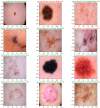High-Precision Skin Disease Diagnosis through Deep Learning on Dermoscopic Images
- PMID: 39329609
- PMCID: PMC11440112
- DOI: 10.3390/bioengineering11090867
High-Precision Skin Disease Diagnosis through Deep Learning on Dermoscopic Images
Abstract
Dermatological conditions are primarily prevalent in humans and are primarily caused by environmental and climatic fluctuations, as well as various other reasons. Timely identification is the most effective remedy to avert minor ailments from escalating into severe conditions. Diagnosing skin illnesses is consistently challenging for health practitioners. Presently, they rely on conventional methods, such as examining the condition of the skin. State-of-the-art technologies can enhance the accuracy of skin disease diagnosis by utilizing data-driven approaches. This paper presents a Computer Assisted Diagnosis (CAD) framework that has been developed to detect skin illnesses at an early stage. We suggest a computationally efficient and lightweight deep learning model that utilizes a CNN architecture. We then do thorough experiments to compare the performance of shallow and deep learning models. The CNN model under consideration consists of seven convolutional layers and has obtained an accuracy of 87.64% when applied to three distinct disease categories. The studies were conducted using the International Skin Imaging Collaboration (ISIC) dataset, which exclusively consists of dermoscopic images. This study enhances the field of skin disease diagnostics by utilizing state-of-the-art technology, attaining exceptional levels of accuracy, and striving for efficiency improvements. The unique features and future considerations of this technology create opportunities for additional advancements in the automated diagnosis of skin diseases and tailored treatment.
Keywords: convolutional neural network (CNN); deep learning; machine learning; random forest (RF); skin disease; support vector machine (SVM).
Conflict of interest statement
The authors declare no conflicts of interest.
Figures





















References
-
- American Cancer Society Key Statistics for Melanoma Skin Cancer. [(accessed on 27 May 2023)]. Available online: https://www.cancer.org/cancer/melanoma-skin-cancer/about/key-statistics.....
-
- World Cancer Research Fund Skin Cancer Statistics. [(accessed on 27 May 2023)]. Available online: https://www.wcrf.org/cancer-trends/skin-cancer-statistics/
-
- Khan H., Ullah I., Shabaz M., Omer M.F., Usman M.T., Guellil M.S., Koo J. Visionary vigilance: Optimized YOLOV8 for fallen person detection with large-scale benchmark dataset. Image Vis. Comput. 2024;26:105195. doi: 10.1016/j.imavis.2024.105195. - DOI
LinkOut - more resources
Full Text Sources
Miscellaneous

